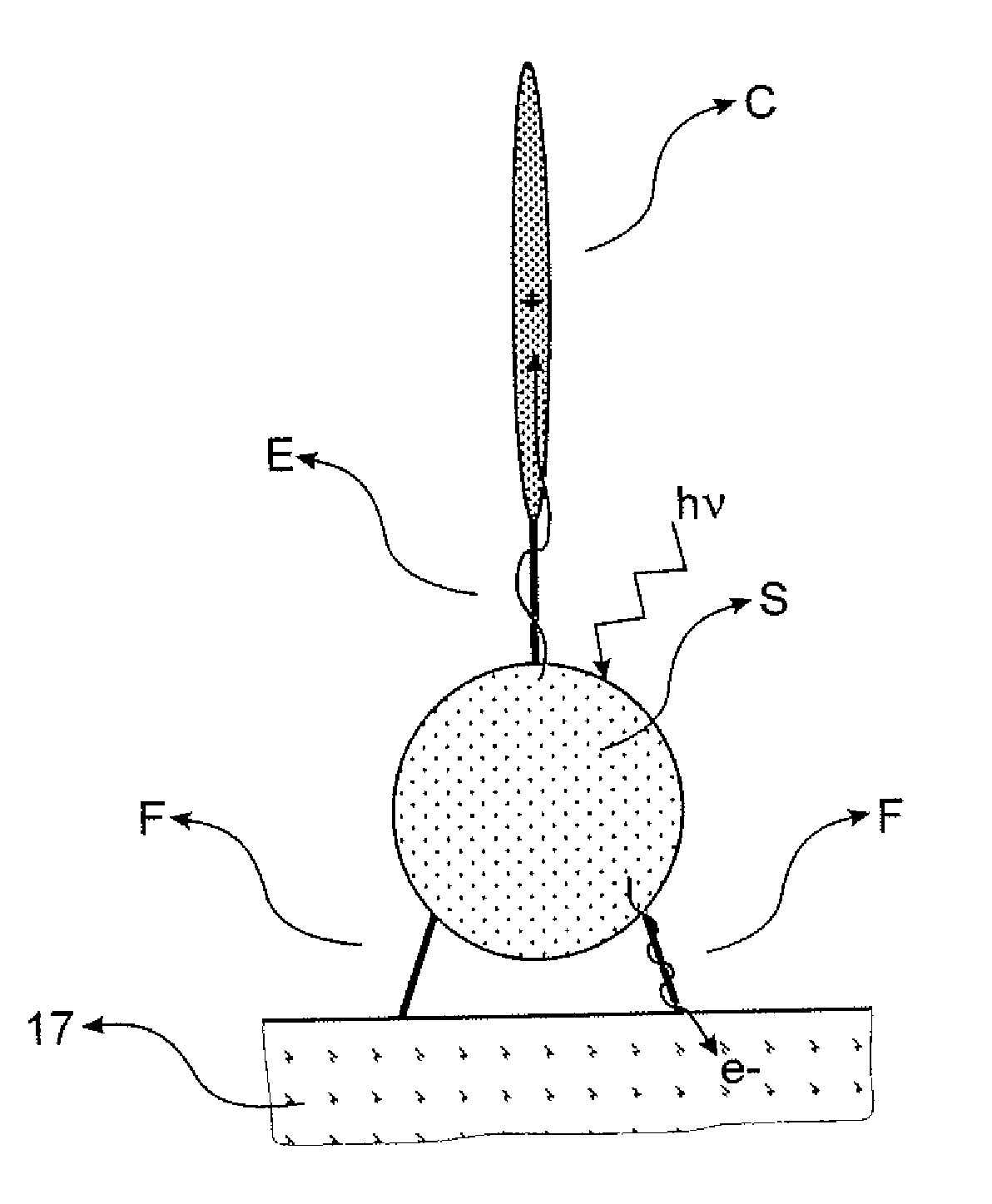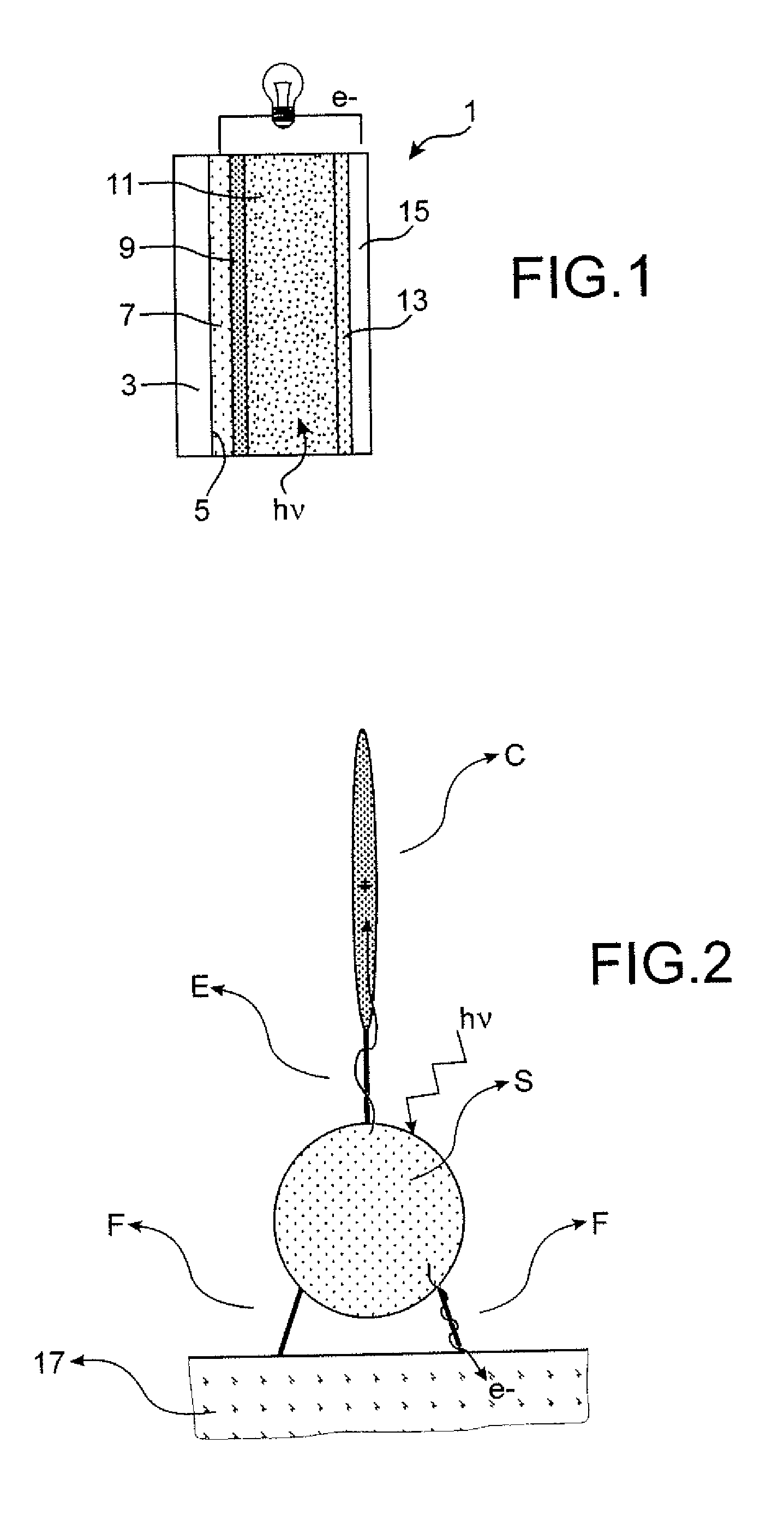Sensitizing Complexes, Process For The Preparation Thereof, Semiconductive Inorganic/Organic Hybrid Material Comprising Them, And Photovoltaic Cell Comprising Said Material
- Summary
- Abstract
- Description
- Claims
- Application Information
AI Technical Summary
Benefits of technology
Problems solved by technology
Method used
Image
Examples
example 1
Synthesis of the Complex 5 (Also Called C13)
[0195]50 mg (0.06 mmol, 1 eq.) of complex 1 as described above, dissolved in 2 mL of distilled DMF and 600 mg (0.12 mmol, 2 eq.) of polymer 2 as described above and (where R is an n-octyl group and n=40) dissolved in 10 mL of distilled THF are introduced into a sealed tube. After three rounds of degassing under argon, 9.5 mg (0.013 mmol, 0.2 eq.) of [1,1′-bis(diphenylphosphino)ferrocene]dichloropalladium (II), 2.5 mg (0.013 mmol, 0.2 eq.) of copper iodide and 0.5 mL of triethylamine are added. The mixture is heated at 90° C. for 20 hours. After cooling of the medium, the solvent is evaporated off under reduced pressure. The product obtained is purified by two successive chromatographies on alumina (column 1 eluent: methanol gradient in chloroform: from 0 to 5%, column 2 eluent: methanol gradient in chloroform: from 0 to 1%), to give a violet-black solid (70 mg, 20%).
[0196]1H NMR: (300 MHz in CDCl3, δ ppm)
[0197]10.56 (d, J3=6 Hz, 1H), 9.06 ...
example 2
Synthesis of the Complex 12′
Synthesis of the 4-bromo-2,5-dimethylbenzaldehyde Intermediate 8
[0207]4 g (15 mmol, 1 eq.) of 1,4-dibromo-2,5-dimethylbenzene are solubilized in 50 mL of distilled THF, in a Schlenk tube under argon. The medium is then cooled to −78° C., then 6.6 mL (16.6 mmol, 1.1 eq.) of BuLi (2.5M in hexane) are added dropwise. After stirring at this temperature for 1 hour, 5.3 mL (68 mmol, 4.5 eq.) of freshly distilled DMF are added. The reaction medium is again stirred at this temperature for 1 hour, and then the temperature returns to ambient temperature overnight. Next, the medium is diluted with a solution of ammonium chloride and then extracted three times with ethyl acetate. The organic phases are combined, dried over magnesium sulphate, and concentrated under reduced pressure. The residue is purified by silica column chromatography (eluent: ethyl acetate / petroleum ether: 80 / 20), so as to give a white solid (m: 1.3 g, yield: 40%).
[0208]1H NMR: (300 MHz in CDCl3,...
example 3
Synthesis of the Complex C3 of Formula Below
(4′-phosphonic-2,2′:6′,2″-terpyridine)(4′-[(3′,4′-dioctyl-2,2′:5′,2″-terthiophen)-5-yl]-2,2′:6′,2″-terpyridine)ruthenium(II) acid ditetrafluoroborate
[0220]
Synthesis of the intermediate complex C3a: 4′-[(3′,4′-dioctyl-2,2′:5′,2″-terthiophene)-5-yl]-2,2′:6′,2″-terpyridine
[0221]
[0222]100 mg (0.25 mmol, 1 eq.) of 4′-trimethylstannyl-2,2′:6′,2″-terpyridine, 200 mg (0.38 mmol, 1.2 eq.) of 5-bromo-3′,4′-dioctyl-2,2′:5′,2″-terthiophene and 15 mL of distilled dioxane are introduced into a sealed tube. After three rounds of degassing under argon, 26 mg (0.025 mmol, 0.045 eq.) of tris(dibenzylideneacetone)dipalladium, 85 mg (0.55 mmol, 2.2 eq.) of caesium fluoride and 18 mg (0.09 mmol, 0.18 eq.) of tri-tert-butylphosphine are added. The mixture is heated at 130° C. for 16 hours. After cooling of the medium, the solution is diluted with ethyl acetate, and washed with a dilute solution of ammonia and with water. The organic phase is dried over magnesiu...
PUM
| Property | Measurement | Unit |
|---|---|---|
| Temperature | aaaaa | aaaaa |
| Temperature | aaaaa | aaaaa |
| Electric potential / voltage | aaaaa | aaaaa |
Abstract
Description
Claims
Application Information
 Login to View More
Login to View More - R&D
- Intellectual Property
- Life Sciences
- Materials
- Tech Scout
- Unparalleled Data Quality
- Higher Quality Content
- 60% Fewer Hallucinations
Browse by: Latest US Patents, China's latest patents, Technical Efficacy Thesaurus, Application Domain, Technology Topic, Popular Technical Reports.
© 2025 PatSnap. All rights reserved.Legal|Privacy policy|Modern Slavery Act Transparency Statement|Sitemap|About US| Contact US: help@patsnap.com



